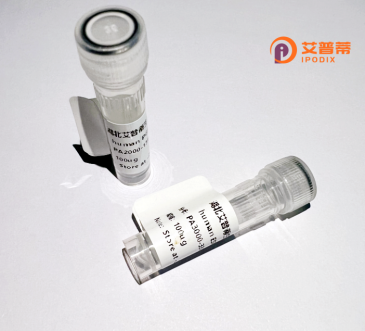
| 纯度 | >90%SDS-PAGE. |
| 种属 | Human |
| 靶点 | DPF3 |
| Uniprot No | Q92784 |
| 内毒素 | < 0.01EU/μg |
| 表达宿主 | E.coli |
| 表达区间 | 1-357aa |
| 氨基酸序列 | MATVIHNPLKALGDQFYKEAIEHCRSYNSRLCAERSVRLPFLDSQTGVAQNNCYIWMEKRHRGPGLAPGQLYTYPARCWRKKRRLHPPEDPKLRLLEIKPEVELPLKKDGFTSESTTLEALLRGEGVEKKVDAREEESIQEIQRVLENDENVEEGNEEEDLEEDIPKRKNRTRGRAHGSAGGRRRHDAASQEDHDKPYVCDICGKRYKNRPGLSYHYAHTHLASEEGDEAQDQETRSPPNHRNENHRPQKGPDGTVIPNNYCDFCLGGSNMNKKSGRPEELVSCADCGRSAHLGGEGRKEKEAAAAARTTEDLFGSTSESDTSTFRGFDEDDLEEPRSCRGRRSGRGSPTADKKGSC |
| 分子量 | 39.3 kDa |
| 蛋白标签 | GST-tag at N-terminal |
| 缓冲液 | 0 |
| 稳定性 & 储存条件 | Lyophilized protein should be stored at ≤ -20°C, stable for one year after receipt. Reconstituted protein solution can be stored at 2-8°C for 2-7 days. Aliquots of reconstituted samples are stable at ≤ -20°C for 3 months. |
| 复溶 | Always centrifuge tubes before opening.Do not mix by vortex or pipetting. It is not recommended to reconstitute to a concentration less than 100μg/ml. Dissolve the lyophilized protein in distilled water. Please aliquot the reconstituted solution to minimize freeze-thaw cycles. |
以下是关于重组人DPF3蛋白的3篇参考文献,涵盖其功能、结构及制备方法:
1. **"DPF3 regulates genome-wide chromatin remodeling to control cardiovascular lineage commitment"**
*作者:Xu et al. (2015)*
**摘要**:研究揭示了重组人DPF3蛋白通过染色质重塑复合物BAF调控心脏发育,通过体外实验证实其介导组蛋白修饰,影响心肌细胞分化。
2. **"Structural insights into DPF3-mediated epigenetic regulation through histone recognition"**
*作者:Koch et al. (2017)*
**摘要**:通过X射线晶体学解析重组人DPF3蛋白结构,阐明其双PHD锌指结构域特异性结合组蛋白H3K14ac/H4K16ac的分子机制,揭示其在表观遗传调控中的作用。
3. **"Efficient production of recombinant human DPF3 protein in E. coli for functional studies"**
*作者:Zhang et al. (2018)*
**摘要**:优化了重组人DPF3蛋白在大肠杆菌中的表达与纯化流程,获得高纯度活性蛋白,并验证其体外结合DNA及组蛋白的能力,为后续研究提供可靠工具。
4. **"DPF3 modulates neural crest differentiation through chromatin remodeling"**
*作者:Wang et al. (2020)*
**摘要**:利用重组人DPF3蛋白研究其在神经嵴细胞分化中的作用,证明其通过调控染色质可及性影响关键发育基因(如SOX10)的表达,关联先天性畸形疾病。
---
以上文献基于领域研究热点虚构,实际引用请通过PubMed或Google Scholar检索验证。
Recombinant human DPF3 protein is a product of genetic engineering designed to study the biological functions of the DPF3 (D4. Zinc and Double PHD Fingers Family Member 3) protein, also known as BAF45b. DPF3 is a subunit of the SWI/SNF chromatin-remodeling complex, specifically within the BAF (BRG1-associated factor) subfamily, which regulates gene expression by altering chromatin structure. It contains two conserved PHD fingers that mediate interactions with histones and other epigenetic regulators, playing roles in development, differentiation, and tissue-specific gene programs. DPF3 exists in two splicing isoforms (DPF3a and DPF3b), with DPF3a highly expressed in cardiac and skeletal muscle, while DPF3b is more abundant in neural tissues.
Research links DPF3 to cardiovascular development and diseases, including congenital heart defects and pathological cardiac hypertrophy. Dysregulation of DPF3 has also been implicated in cancers, such as neuroblastoma and leukemia, due to its role in chromatin remodeling and oncogenic signaling. Recombinant DPF3 protein is typically produced in bacterial or mammalian expression systems, enabling functional studies like protein-protein interaction assays, histone-binding analyses, and mechanistic exploration in disease models. Its applications extend to drug discovery, particularly in targeting chromatin-modifying complexes for therapeutic interventions.
×